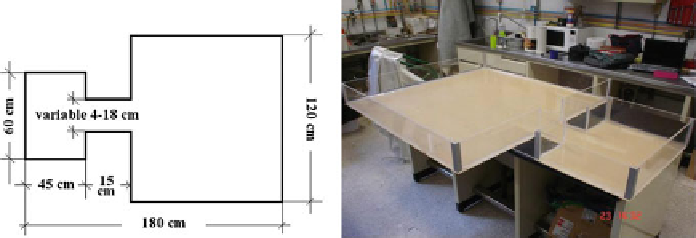Environmental Engineering Reference
In-Depth Information
(
2010
) studied the transport of dust by two identical point vortices rotating around
a common center. They found that the centrifugal and Coriolis forces enhance the
dispersion of particles and that if the drag force is dominant, the particle trajectories
exhibit chaotic behavior, leading to an increase of mixing. Finally, some numerical
simulations of the system considered in this paper show that a pair of counter rotat-
ing vortices (a dipole) detaches from the channel in each period (López-Sánchez and
Ruiz-Chavarría
2013a
). The existence of this dipole enhances the mass transport,
because the velocity is considerably greater in the region between the vortices. Par-
ticles are sucked into that region and expelled forward. Some particles are deposited
in the region where dipole passes and others are pushed away from the symmetry
axis. According to the numerical and experimental evidence (Lacaze et al.
2010
),
in shallow waters, apart from the two eddies in this flow, there is a spanwise vortex
moving in front of the dipole. The transverse vortex produces lift and enables the
motion of particles located at the bottom. It has been shown that particles accumu-
late in certain regions (López-Sánchez and Ruiz-Chavarría
2013a
) or follow chaotic
trajectories (López-Sánchez and Ruiz-Chavarría
2012
). In this system two dimen-
sionless parameter are relevant, the first one is the Reynolds number (
Re
=
UH
/ʽ
),
and the second is the Strouhal number, defined as
S
UT
, where
U
is a represen-
tative velocity,
H
is the channel width,
T
is the driving period and
=
H
/
ʽ
is the kinematic
viscosity. The Strouhal number is a dimensionless frequency.
This paper is organized as follows. In Sect.
2
we describe the experimental setup.
In Sect.
3
we show some results and we made a comparison with data reported in the
literature. In the last section we draw conclusions.
2 Experimental Setup
The experiments were performed in a container composed of two basins connected
by a channel, as shown in Fig.
1
. The dimensions of the smaller basin are 45 cm
×
60 cm
×
15 cm, whereas the dimensions of the larger one are 120 cm
×
120 cm
×
Fig. 1
Left
Dimensions of the container used to model the transport of particles.
Right
Snapshot
of the container


Search WWH ::

Custom Search